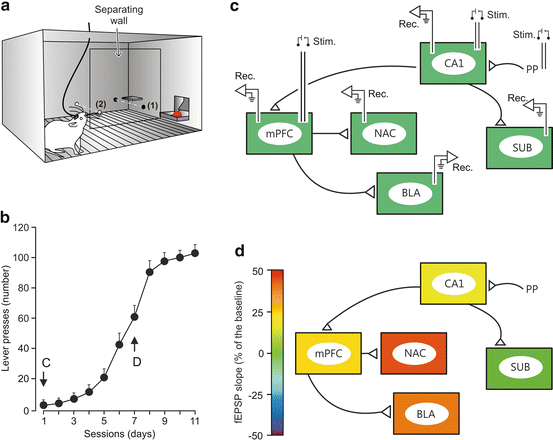Fig. 1
A diagrammatic representation of synaptic weights present in the hippocampal circuit of behaving rabbits during classical conditioning (b, session 1; c, session 8) of eyelid responses using a delay conditioning paradigm. The color code is illustrated in (a). In brief, animals were implanted with stimulating (St.) electrodes in the perforant pathway, the Schaffer collateral/commissural pathway, or in the contralateral CA3 area, and with recording electrodes (Rec.) in the dentate gyrus (DG), and the hippocampal CA3 and CA1 areas. Synaptic activation took place during the CS (tone)—US (air puff) interval

Fig. 2
An example of the quantitative analysis for changes in synaptic strength taking place in different hippocampal and prefrontal synapses during the acquisition of an instrumental learning task. (a) Experimental design. The selected synapses were activated when the animal approached to the lever to press it, i.e., when crossing the indicated photoelectric cells. (b) Acquisition curve. (c, d) Synaptic weights (fEPSP slopes) recorded during the first and the seventh training sessions. Abbreviations: BLA basolateral amygdala, mPFC medial prefrontal cortex, NAC nucleus accumbens septi, Sub subiculum
2 Methods
In a first series of experiments, animals (rabbits) were prepared for the chronic recording of the electromyographic activity of orbicularis oculi muscle and of synaptic activity (field excitatory post-synaptic potentials, fEPSPs) evoked at the intrinsic hippocampal circuit or by the stimulation of its main input, i.e., the perforant pathway (Fig. 1). Rabbits were trained with a Pavlovian conditioning protocol (i.e., a classical eyeblink conditioning). Field EPSPs were evoked in the different hippocampal synapses at the interval between conditioned (a tone) and unconditioned (an air puff presented to the cornea) stimulus presentations. The simultaneous recording of synaptic activities at different neural sites offered a still unknown picture of the specific functional states taking place at hippocampal during the actual acquisition process.
In a second series of experiments, Wistar rats were implanted with stimulating and recording electrodes in selected sites of the intrinsic hippocampal circuit and/or in the perforant pathway. Rats were trained in a Skinner box to press a lever in order to obtain a small piece of food. Animals were stimulated at different hippocampal and prefrontal synapses during their performance in the Skinner box task (see Fig. 2).
For analysis, we used here mathematical tools designed in our laboratory to obtain the state functions characterizing the acquisition of new motor and/or cognitive skills. The programs/scripts used here were developed by one of us (R.S.-C.) with the help of MATLAB (The MathWorks, Natick, MA, USA) routines [3].
3 Results
A few years ago, we showed that the hippocampal CA3→CA1 synapse presents a significant change in strength during the acquisition of a type of associative learning task in alert behaving mice: i.e., the classical conditioning of eyelid responses [1, 2]. It was also shown in this study that this learning-dependent change in synaptic strength was linearly related with the rate of acquisition of the conditioned eyeblinks, suggesting a more-or-less direct relationship between the acquisition process and the underlying synaptic plastic changes. At that moment, it was assumed that other synapses present in the intrinsic hippocampal circuit and the many other related to its main inputs (perforant pathway) and outputs (other cortical structures) should present similar changes in synaptic strength [2]. Indeed, we have addressed this question in a recently published study [4] and with different ongoing experiments being carried out in our laboratory. As illustrated in Fig. 1, the different hippocampal synapses present a complex evolution of their synaptic strength across the successive conditioning sessions. Thus, it was clear that each synapse in the hippocampal network contributes in a different way to the acquisition process. In addition, we have carried out a similar classical eyeblink conditioning in behaving mice, including the analysis of fEPSPs changes taking place in nine different hippocampal synapses across conditioning (not illustrated). Here again, changes in synaptic strength across conditioning indicated the presence of a timed and specific plasticity pattern characterizing this type of associative learning.
Stay updated, free articles. Join our Telegram channel

Full access? Get Clinical Tree







